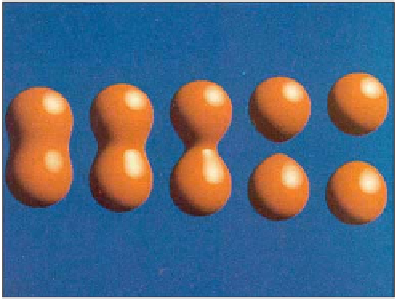Graphics Reference
In-Depth Information
Figure 14.16: Blobby models, each defined by the isocontour of a sum of 3D Gaussian
density functions [Bli82a]. (Credit: Courtesy of James Blinn © 1982 ACM, Inc. Reprinted
by permission.)
What about implicit surfaces that do not admit efficient closed-form solutions?
If the implicit surface function is continuous and maps points inside the object to
negative values and points outside the object to positive values, then any root-
finding method such as Newton-Raphson [Pre95] will find zero points, that is, it
will find the surface. The term “implicit surface” usually refers to this kind of
model and intersection algorithm.
Implicit surfaces that are defined by the sum of some simple basis functions
with different origins are favored for modeling organic, “blobby” shapes (see Fig-
ure 14.16). This is called
blobby modeling
and
metaball modeling
[Bli82a].
We've seen that smooth shapes can be modeled by arbitrary expressions defin-
ing their surface curves through three dimensions and by the implicit surface
defined by a parametric sum of fixed functions. Spline curves and patches and
subdivision curves and surfaces are alternative representations that fall between
these extremes. A
spline
is simply a piecewise-polynomial curve, typically repre-
sented on each interval as a linear combination of four predefined basis functions,
where the coefficients are
points
. Thus, the curve can be represented by just storing



